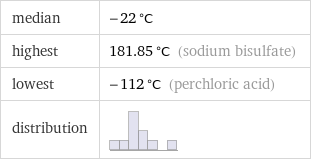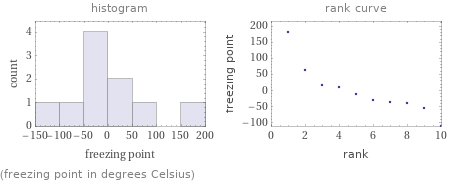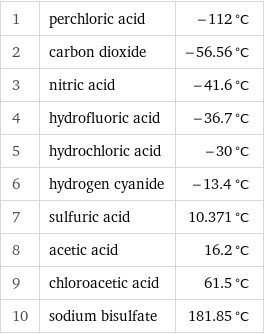Input interpretation

Arrhenius acids | freezing point
Summary

median | -22 °C highest | 181.85 °C (sodium bisulfate) lowest | -112 °C (perchloric acid) distribution |
Distribution plots

(freezing point in degrees Celsius)
Freezing point rankings

1 | perchloric acid | -112 °C 2 | carbon dioxide | -56.56 °C 3 | nitric acid | -41.6 °C 4 | hydrofluoric acid | -36.7 °C 5 | hydrochloric acid | -30 °C 6 | hydrogen cyanide | -13.4 °C 7 | sulfuric acid | 10.371 °C 8 | acetic acid | 16.2 °C 9 | chloroacetic acid | 61.5 °C 10 | sodium bisulfate | 181.85 °C
Unit conversions for median freezing point -22 °C

≈ 250 K (kelvins)

≈ -7 °F (degrees Fahrenheit)

≈ 450 °R (degrees Rankine)

≈ -17 °Ré (degrees Réaumur)

≈ -4 °Rø (degrees Rømer)
Comparison for median freezing point -22 °C

40 °C below temperature at STP (standard temperature and pressure), using the convention of European and South American natural gas companies (15 °C)

22 °C below temperature at STP (standard temperature and pressure), using the International Union of Pure and Applied Chemistry convention (0 °C)

4 °C below temperature of the ice/salt mixture defining the zero point of the Fahrenheit temperature scale (0 °F)
Corresponding quantities

Thermodynamic energy E from E = kT: | 22 meV (millielectronvolts)

Blackbody energy flux Φ from Φ = σT^4: | 227 W/m^2 (watts per square meter)

Approximate luminous exitance from a planar blackbody radiator perpendicular to its surface: | 6.8×10^-27 lx (lux)